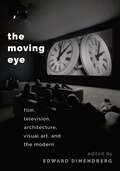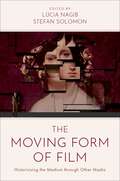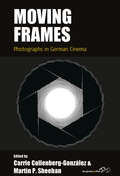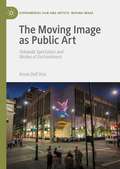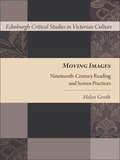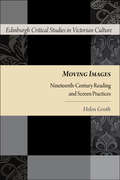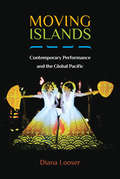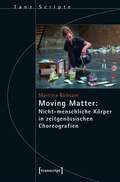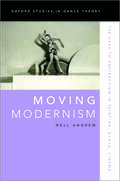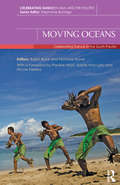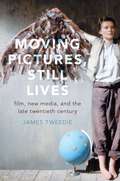- Table View
- List View
The Moving Body: Teaching Creative Theatre (Theatre Makers)
by Jacques Lecoq'In life, I want students to be alive and on stage I want them to be artists' Jacques LecoqJacques Lecoq was one of the most inspirational theatre teachers of our age. In The Moving Body, he shares with us first-hand his unique philosophy of performance, improvisation, masks, movement and gesture, which together form one of the greatest influences on contemporary theatre.Neutral mask, character mask and counter masks, bouffons, acrobatics, commedia, clowns and complicity: all the famous Lecoq techniques are covered in this book - techniques that have made their way into the work of former collaborators and students including Dario Fo, Ariane Mnouchkine, Yasmina Reza and Theatre de Complicite. The book contains a foreword by Simon McBurney, a critical introduction by Mark Evans and an afterword by Fay Lecoq, Director of the International Theatre School in Paris.
The Moving Eye: Film, Television, Architecture, Visual Art and the Modern
Once the province of film and media scholars, today the moving image is of broad concern to historians of art and architecture and designers of everything from websites to cities. As museums and galleries devote increasing space to video installations which no longer presuppose a fixed viewer, urban space becomes envisioned and planned through "fly throughs," and technologies such as GPS add data to the experience of travel, moving images have captured the attention of geographers and scholars across the humanities and social sciences. Their practice of "mobility studies" is remaking how we understand a contemporary world in relentless motion. Media theorist and historian Anne Friedberg (1952-2009) was among the first practitioners of visual studies to theorize the experience of vision in motion. Her books have become key points of reference in the discussion of the windows that frame images and the viewers in motion who perceive them. Although widely influential beyond her own discipline, Friedberg's work has never been the subject of an extended study. The Moving Eye: Film, Television, Architecture, Visual Art and the Modern gathers together essays by renowned thinkers in media studies, art history, architecture, and museum studies to consider the rich implications of her work for understanding film and video, new media, visual art, architecture, exhibition design, urban space, and virtual reality. Ranging from early cinema, to works by Le Corbusier, Sergei Eisenstein, Gordon Matta-Clark, and Pierre Huyghe, to theories of the image in motion informed by psychoanalysis, theories of the public sphere, and animal studies, each of the nine essays in the book advances the lines of inquiry commenced by Friedberg.
MOVING EYE C: Film, Television, Architecture, Visual Art and the Modern
by Edward DimendbergOnce the province of film and media scholars, today the moving image is of broad concern to historians of art and architecture and designers of everything from websites to cities. As museums and galleries devote increasing space to video installations which no longer presuppose a fixed viewer, urban space becomes envisioned and planned through "fly throughs," and technologies such as GPS add data to the experience of travel, moving images have captured the attention of geographers and scholars across the humanities and social sciences. Their practice of "mobility studies" is remaking how we understand a contemporary world in relentless motion. Media theorist and historian Anne Friedberg (1952-2009) was among the first practitioners of visual studies to theorize the experience of vision in motion. Her books have become key points of reference in the discussion of the windows that frame images and the viewers in motion who perceive them. Although widely influential beyond her own discipline, Friedberg's work has never been the subject of an extended study. The Moving Eye: Film, Television, Architecture, Visual Art and the Modern gathers together essays by renowned thinkers in media studies, art history, architecture, and museum studies to consider the rich implications of her work for understanding film and video, new media, visual art, architecture, exhibition design, urban space, and virtual reality. Ranging from early cinema, to works by Le Corbusier, Sergei Eisenstein, Gordon Matta-Clark, and Pierre Huyghe, to theories of the image in motion informed by psychoanalysis, theories of the public sphere, and animal studies, each of the nine essays in the book advances the lines of inquiry commenced by Friedberg.
Moving Figures: Class and Feeling in the Films of Jia Zhangke
by Corey Kai Nelson SchultzA fresh perspective on the hugely successful Latin American films released at the turn of the 21st century
Moving Figures: Class and Feeling in the Films of Jia Zhangke (Edinburgh Studies In East Asian Film Ser.)
by Corey Kai Nelson SchultzExamines the history of early cinema in Scotland from its inception in 1896 until the 1930s
The Moving Form of Film: Historicising the Medium through Other Media
by Lúcia Nagib and Stefan SolomonThe Moving Form of Film: Historicizing the Medium through Other Media charts the ways in which crossing borders between film and other arts and media can provide an encompassing, inclusive, and non-teleological understanding of film history. Evolutionary narratives of cinema have traditionally adopted the Second World War as a watershed that separates 'classical' Hollywood films from 'modern' European productions, a scheme that subjects the entire world to the cinematic history of two hegemonic centres. In turn, histories of film as a technological medium have focused on the specificity of cinema as it gradually separated from the other art and medial forms - theatre, dance, fairground spectacle, painting, literature, still photography and other pre-cinematic modes. Taking an ambitious step forward with relation to these approaches, this book focuses on the fluid quality of the film form by exploring an array of exciting and often neglected artistic expressions worldwide as they compare and interconnect films across temporal, geographical, and cultural borders. By observing the ebb and flow of film's contours within the bounds of other artistic and medial expressions, the chapters aspire to establish a flexible historical platform for the moving form of film, posited, from production to consumption, as a transforming and transformative medium.
The Moving Form of Film: Historicising the Medium through Other Media
The Moving Form of Film: Historicizing the Medium through Other Media charts the ways in which crossing borders between film and other arts and media can provide an encompassing, inclusive, and non-teleological understanding of film history. Evolutionary narratives of cinema have traditionally adopted the Second World War as a watershed that separates 'classical' Hollywood films from 'modern' European productions, a scheme that subjects the entire world to the cinematic history of two hegemonic centres. In turn, histories of film as a technological medium have focused on the specificity of cinema as it gradually separated from the other art and medial forms - theatre, dance, fairground spectacle, painting, literature, still photography and other pre-cinematic modes. Taking an ambitious step forward with relation to these approaches, this book focuses on the fluid quality of the film form by exploring an array of exciting and often neglected artistic expressions worldwide as they compare and interconnect films across temporal, geographical, and cultural borders. By observing the ebb and flow of film's contours within the bounds of other artistic and medial expressions, the chapters aspire to establish a flexible historical platform for the moving form of film, posited, from production to consumption, as a transforming and transformative medium.
Moving Frames: Photographs in German Cinema (Film Europa #26)
by Carrie Collenberg-González Martin P. SheehanAs the building blocks of moving pictures, photographs have played an integral role in cinema since the dawn of the medium—a relationship that has grown more complexly connected even as the underlying technologies continue to evolve. Moving Frames explores the use of photographs in German films from Expressionism to the Berlin School, addressing the formal and narrative roles that photographs play as well as the cultural and historical contexts out of which these films emerged. Looking beyond and within the canon, the editors gather stimulating new insights into the politics of surveillance, resistance, representation, and collective memory functioning through photographic rupture and affect in German cinema.
Moving Frames: Photographs in German Cinema (Film Europa #26)
As the building blocks of moving pictures, photographs have played an integral role in cinema since the dawn of the medium—a relationship that has grown more complexly connected even as the underlying technologies continue to evolve. Moving Frames explores the use of photographs in German films from Expressionism to the Berlin School, addressing the formal and narrative roles that photographs play as well as the cultural and historical contexts out of which these films emerged. Looking beyond and within the canon, the editors gather stimulating new insights into the politics of surveillance, resistance, representation, and collective memory functioning through photographic rupture and affect in German cinema.
The Moving Image as Public Art: Sidewalk Spectators and Modes of Enchantment (Experimental Film and Artists’ Moving Image)
by Annie Dell'AriaThis book maps the presence of moving images within the field of public art through encounters with passersby. It argues that far from mere distraction or spectacle, moving images can produce moments of enchantment that can renew, intensify, or challenge our everyday engagement with public space and each other. These artworks also offer frameworks for understanding how moving images operate in public space—how they move viewers and reconfigure the site of the screen. Each chapter explores a mode of address that examines how artists and curators leverage the moving image’s attentional power to engage audiences, create spaces, make place, and challenge assumptions. This book also examines the difficulties and compromises that arise when using urban screens for public art.
The Moving Image Workshop: Introducing animation, motion graphics and visual effects in 45 practical projects (Required Reading Range)
by Heather D. FreemanIf you need a fun, hands-on introduction to core animation techniques - then look no further! Heather Freeman guides you through a wide range of practical projects, helping you establish and build skills in narrative animation, motion graphics and visual effects.Each chapter begins by summarizing historical and theoretical concerns and connecting them with current practice and applications - all beautifully illustrated with stills from classic commercial and independent films, as well as contemporary examples from student work. Having established this context, the remainder of the chapter focuses on walking readers through their own creative projects. Topics covered include early animation technologies and techniques, scenes and staging, character animation, animated type, visual effects and motion graphics, pre- through post-production and experimental approaches to motion graphics. Dozens of sample files are available online, for experimentation and to get readers started on each exercise. The companion website also includes example animations as well as links to recommended software tutorials, recommended artist websites, blogs and animation channels.
The Moving Image Workshop: Introducing animation, motion graphics and visual effects in 45 practical projects (Required Reading Range Ser.)
by Heather D. FreemanIf you need a fun, hands-on introduction to core animation techniques - then look no further! Heather Freeman guides you through a wide range of practical projects, helping you establish and build skills in narrative animation, motion graphics and visual effects.Each chapter begins by summarizing historical and theoretical concerns and connecting them with current practice and applications - all beautifully illustrated with stills from classic commercial and independent films, as well as contemporary examples from student work. Having established this context, the remainder of the chapter focuses on walking readers through their own creative projects. Topics covered include early animation technologies and techniques, scenes and staging, character animation, animated type, visual effects and motion graphics, pre- through post-production and experimental approaches to motion graphics. Dozens of sample files are available online, for experimentation and to get readers started on each exercise. The companion website also includes example animations as well as links to recommended software tutorials, recommended artist websites, blogs and animation channels.
Moving Images: Nineteenth-Century Reading and Screen Practices (Edinburgh Critical Studies in Victorian Culture (PDF))
by Helen Groth"Examines the moving image in relation to nineteenth-century literature, theories of mind, and visual media This book examines how the productive interplay between nineteenth-century literary and visual media paralleled the emergence of a modern psychological understanding of the ways in which reading, viewing and dreaming generate moving images in the mind. Reading between these parallel histories of mind and media reveals a dynamic conceptual, aesthetic and technological engagement with the moving image that, in turn, produces a new understanding of the production and circulation of the work of key nineteenth-century writers, such as Lord Byron, Walter Scott, Lewis Carroll, Charles Dickens and William Makepeace Thackeray. As Helen Groth shows, this engagement is both typical of the nineteenth-century in its preoccupation with questions of automatism and volition (unconscious and conscious thought), spirit and materiality, art and machine, but also definitively modern in its secular articulation of the instructive and entertaining applications of making images move both inside and outside the mind."
Moving Images: Nineteenth-Century Reading and Screen Practices (Edinburgh Critical Studies in Victorian Culture (PDF))
by Helen GrothThis book examines how the interplay between nineteenth-century literary and visual media paralleled the emergence of a modern psychological understanding of the ways in which reading, viewing and dreaming generate moving images in the mind.
Moving Islands: Contemporary Performance and the Global Pacific (Theater: Theory/Text/Performance)
by Diana LooserMoving Islands reveals the international and intercultural connections within contemporary performance from Oceania, focusing on theater, performance art, art installations, dance, film, and activist performance in sites throughout Oceania and in Australia, Asia, North America, and Europe. Diana Looser’s study moves beyond a predictable country-specific or island-specific focus to encompass an entire region defined by diversity and global exchange, showing how performance operates to frame social, artistic, and political relationships across widely dispersed locations. The study also demonstrates how Oceanian performance contributes to international debates about diaspora, indigeneity, urbanization, and environmental sustainability. The author considers the region’s unique cultural and geographic dynamics as she brings forth the paradigm of transpasifika to suggest a way of understanding these intercultural exchanges and connections, with the aim to “rework the cartographic and disciplinary priorities of transpacific studies to privilege the activities of Islander peoples.”
Moving Matter: Nicht-menschliche Körper in zeitgenössischen Choreografien (TanzScripte #61)
by Martina RuhsamIn experimentellen Choreografien und Performances ist seit etwa 2008 eine lebhafte Auseinandersetzung mit der Wirkmächtigkeit (teil-)autonomer Dinge und der Verwobenheit menschlicher und nicht-menschlicher Akteure zu beobachten. Welche Anliegen sind mit der Inszenierung einer verteilten Handlungsmacht verknüpft? In ausführlichen Inszenierungsanalysen macht Martina Ruhsam die Akteur-Netzwerk-Theorie und den Agentiellen Realismus von Karen Barad für die Performancetheorie produktiv. Sie schlägt eine politische Lesart ausgewählter posthumanistischer Choreografien vor und reflektiert über deren Relevanz im Hinblick auf eine politische Ökologie.
Moving Modernism: The Urge to Abstraction in Painting, Dance, Cinema (Oxford Studies in Dance Theory)
by Nell AndrewThe emergence of modern dance and the early history of cinema ran concurrent with the European avant-garde's development of pictorial abstraction in the first decades of the 20th century. However, many assume that modernist abstraction resulted from a century of natural, autonomous evolution to painting styles and tastes. In Moving Modernism, author Nell Andrew challenges this assumption. By examining dance and film created during this period, she argues that performative modes of art created the link between bodily movement and movement depicted in modernist paintings. In a seeming paradox, dance and film - durational arts, involving real bodies in space-participated in the development of abstract art. With archival material collected in North America and Europe, Moving Modernism resurfaces lost performances, identifies working methods, and establishes the circles of aesthetic influence and reception for avant-garde dance pioneers and experimental film makers from the turn of the century to the interwar period. Reexamining the motivation that fueled the emergence of abstraction, Andrew claims that painters sought meaning not only in the material and formal picture but also in temporal and sensorial experience. Andrew looks at major figures and intellectual movements including Loïe Fuller and Symbolism; Valentine de Saint-Point and the Cubo-Futurist and neo-Symbolist movements; and early cinematic abstraction from Edison and the Lumières to Hans Richter and Marcel Duchamp. Close examinations of each figure show that theatrical display, embodied self-projection, and kinesthetic desire are not necessarily in opposition to pictorial abstraction; in fact, they expand our understanding of the urges that created modern art.
Moving Modernism: The Urge to Abstraction in Painting, Dance, Cinema (Oxford Studies in Dance Theory)
by Nell AndrewThe emergence of modern dance and the early history of cinema ran concurrent with the European avant-garde's development of pictorial abstraction in the first decades of the 20th century. However, many assume that modernist abstraction resulted from a century of natural, autonomous evolution to painting styles and tastes. In Moving Modernism, author Nell Andrew challenges this assumption. By examining dance and film created during this period, she argues that performative modes of art created the link between bodily movement and movement depicted in modernist paintings. In a seeming paradox, dance and film - durational arts, involving real bodies in space-participated in the development of abstract art. With archival material collected in North America and Europe, Moving Modernism resurfaces lost performances, identifies working methods, and establishes the circles of aesthetic influence and reception for avant-garde dance pioneers and experimental film makers from the turn of the century to the interwar period. Reexamining the motivation that fueled the emergence of abstraction, Andrew claims that painters sought meaning not only in the material and formal picture but also in temporal and sensorial experience. Andrew looks at major figures and intellectual movements including Loïe Fuller and Symbolism; Valentine de Saint-Point and the Cubo-Futurist and neo-Symbolist movements; and early cinematic abstraction from Edison and the Lumières to Hans Richter and Marcel Duchamp. Close examinations of each figure show that theatrical display, embodied self-projection, and kinesthetic desire are not necessarily in opposition to pictorial abstraction; in fact, they expand our understanding of the urges that created modern art.
Moving Notation
by Jill Beck Joseph ReiserDesigned specifically for university-level study, Moving Notation will benefit students and teachers of both dance and music, offering a complete introduction to the theory and practice of musical rhythm and elementary Labanotation. Performing Arts Studies aims to provide stimulating resource books of both a practical and philosophical nature for teachers and students of the performing arts: music, dance, theatre, film, radio, video, oral poetry, performance art, and multi-media forms.
Moving Notation (Performing Arts Studies #Vol. 6)
by Jill Beck Joseph ReiserDesigned specifically for university-level study, Moving Notation will benefit students and teachers of both dance and music, offering a complete introduction to the theory and practice of musical rhythm and elementary Labanotation. Performing Arts Studies aims to provide stimulating resource books of both a practical and philosophical nature for teachers and students of the performing arts: music, dance, theatre, film, radio, video, oral poetry, performance art, and multi-media forms.
Moving Oceans: Celebrating Dance in the South Pacific (Celebrating Dance in Asia and the Pacific)
by Nicholas Rowe Ralph BuckCelebrating the diversity of dance across the South Pacific, this volume studies the various experiences, motivations and aims for dance, emerging from the voices of dance professionals in the islands. In particular, it focuses on the interplay of cultures and pathways of migration as people move across the region discovering new routes and connections.
Moving Oceans: Celebrating Dance in the South Pacific (Celebrating Dance in Asia and the Pacific)
by Nicholas Rowe Ralph BuckCelebrating the diversity of dance across the South Pacific, this volume studies the various experiences, motivations and aims for dance, emerging from the voices of dance professionals in the islands. In particular, it focuses on the interplay of cultures and pathways of migration as people move across the region discovering new routes and connections.
The (Moving) Pictures Generation: The Cinematic Impulse in Downtown New York Art and Film
by V. DikaBeginning in the late 1970s, a number of visual artists in downtown New York City returned to an exploration of the cinematic across mediums. Vera Dika considers their work within a greater cultural context and probes for a deeper understanding of the practice.
Moving Pictures, Still Lives: Film, New Media, and the Late Twentieth Century
by James TweedieMoving Pictures, Still Lives revisits the cinematic and intellectual atmosphere of the late twentieth century. Against the backdrop of the historical fever of the 1980s and 1990s-the rise of the heritage industry, a global museum-building boom, and a cinematic fascination with costume dramas and literary adaptations-it explores the work of artists and philosophers who complicated the usual association between tradition and the past or modernity and the future. Author James Tweedie retraces the "archaeomodern turn" in films and theory that framed the past as a repository of abandoned but potentially transformative experiments. He examines late twentieth-century filmmakers who were inspired by old media, especially painting, and often viewed those art forms as portals to the modern past. In detailed discussions of Alain Cavalier, Terence Davies, Jean-Luc Godard, Peter Greenaway, Derek Jarman, Agnès Varda, and other key directors, the book concentrates on films that fill the screen with a succession of tableaux vivants, still lifes, illuminated manuscripts, and landscapes. It also considers three key figures-Walter Benjamin, Gilles Deleuze, and Serge Daney-who grappled with the late twentieth century's characteristic concerns, including history, memory, and belatedness. It reframes their theoretical work on film as a mourning play for past revolutions and a means of reviving the possibilities of the modern age (and its paradigmatic medium, cinema) during periods of political and cultural retrenchment. Looking at cinema and the century in the rear-view mirror, the book highlights the unrealized potential visible in the history of film, as well as the cinematic phantoms that remain in the digital age.
MOVING PICTURES,STILL LIVES C: Film, New Media, and the Late Twentieth Century
by James TweedieMoving Pictures, Still Lives revisits the cinematic and intellectual atmosphere of the late twentieth century. Against the backdrop of the historical fever of the 1980s and 1990s-the rise of the heritage industry, a global museum-building boom, and a cinematic fascination with costume dramas and literary adaptations-it explores the work of artists and philosophers who complicated the usual association between tradition and the past or modernity and the future. Author James Tweedie retraces the "archaeomodern turn" in films and theory that framed the past as a repository of abandoned but potentially transformative experiments. He examines late twentieth-century filmmakers who were inspired by old media, especially painting, and often viewed those art forms as portals to the modern past. In detailed discussions of Alain Cavalier, Terence Davies, Jean-Luc Godard, Peter Greenaway, Derek Jarman, Agnès Varda, and other key directors, the book concentrates on films that fill the screen with a succession of tableaux vivants, still lifes, illuminated manuscripts, and landscapes. It also considers three key figures-Walter Benjamin, Gilles Deleuze, and Serge Daney-who grappled with the late twentieth century's characteristic concerns, including history, memory, and belatedness. It reframes their theoretical work on film as a mourning play for past revolutions and a means of reviving the possibilities of the modern age (and its paradigmatic medium, cinema) during periods of political and cultural retrenchment. Looking at cinema and the century in the rear-view mirror, the book highlights the unrealized potential visible in the history of film, as well as the cinematic phantoms that remain in the digital age.

